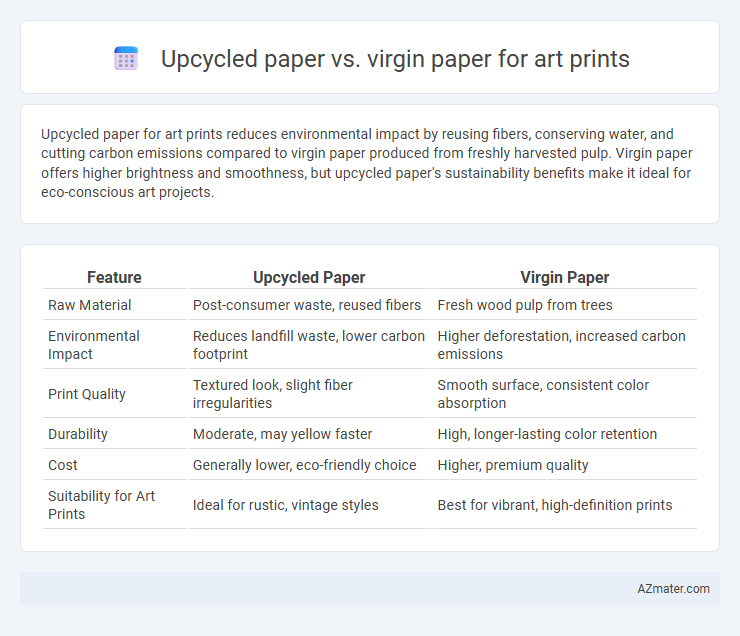Upcycled paper for art prints reduces environmental impact by reusing fibers, conserving water, and cutting carbon emissions compared to virgin paper produced from freshly harvested pulp. Virgin paper offers higher brightness and smoothness, but upcycled paper's sustainability benefits make it ideal for eco-conscious art projects.
Table of Comparison
| Feature | Upcycled Paper | Virgin Paper |
|---|---|---|
| Raw Material | Post-consumer waste, reused fibers | Fresh wood pulp from trees |
| Environmental Impact | Reduces landfill waste, lower carbon footprint | Higher deforestation, increased carbon emissions |
| Print Quality | Textured look, slight fiber irregularities | Smooth surface, consistent color absorption |
| Durability | Moderate, may yellow faster | High, longer-lasting color retention |
| Cost | Generally lower, eco-friendly choice | Higher, premium quality |
| Suitability for Art Prints | Ideal for rustic, vintage styles | Best for vibrant, high-definition prints |
Introduction to Upcycled vs Virgin Paper
Upcycled paper is crafted from recycled materials, significantly reducing environmental impact through lower energy consumption and less waste compared to virgin paper, which is made from fresh wood pulp sourced directly from trees. Virgin paper offers superior fiber strength and brightness, often favored for high-quality art prints where color vibrancy and detail are paramount. Choosing between upcycled and virgin paper for art prints involves balancing eco-friendly benefits with the desired texture, durability, and print fidelity.
Environmental Impact Comparison
Upcycled paper for art prints significantly reduces environmental impact by consuming less energy and water compared to virgin paper production, which involves intensive deforestation and chemical processing. The recycling process of upcycled paper lowers greenhouse gas emissions and minimizes landfill waste, contributing to sustainability. Choosing upcycled paper supports conservation of natural resources and lowers the carbon footprint associated with art print manufacturing.
Character and Texture Differences
Upcycled paper for art prints offers a distinctive, often uneven texture with visible fibers and occasional specks, creating a rustic, organic character that enhances the uniqueness of the artwork. Virgin paper, made from fresh wood pulp, provides a smooth and consistent surface ideal for high-detail prints with vibrant color accuracy and sharpness. The choice between upcycled and virgin paper affects the tactile experience and visual depth, with upcycled fibers imparting a handcrafted aesthetic versus the refined, polished finish of virgin paper.
Print Quality and Color Fidelity
Upcycled paper offers eco-friendly benefits but may sometimes exhibit slight texture variations that can affect print quality and color fidelity in fine art prints. Virgin paper, manufactured from fresh fibers, typically provides a smoother surface and consistent whiteness, enhancing sharpness and vibrant color reproduction in detailed artworks. Artists seeking precise color accuracy and crisp detail often prefer virgin paper for optimal print results.
Cost Analysis: Upcycled vs Virgin Paper
Upcycled paper typically offers a lower cost per sheet compared to virgin paper due to the use of recycled fibers and reduced raw material expenses, making it a budget-friendly option for art prints. Virgin paper, produced from fresh wood pulp, often incurs higher manufacturing costs which translate to a higher price point but can deliver superior brightness and texture quality required for premium art prints. Considering long-term environmental savings, upcycled paper reduces waste management costs and carbon footprint, which can indirectly influence overall production expenses.
Availability and Sourcing
Upcycled paper for art prints is sourced from recycled materials, significantly reducing environmental impact and promoting sustainability, though it may have limited availability depending on local recycling facilities and demand. Virgin paper, produced from freshly harvested wood pulp, offers consistent quality and broader availability due to established supply chains and industrial-scale production. Artists seeking eco-friendly options often weigh upcycled paper's limited but growing accessibility against the reliable sourcing and abundant inventory of virgin paper.
Archival Quality and Longevity
Upcycled paper for art prints often lacks the archival quality and longevity found in virgin paper due to the presence of residual lignin and lower cellulose purity, which can cause yellowing and degradation over time. Virgin paper, typically made from high-grade cotton or wood pulp, offers superior durability, acid-free characteristics, and resistance to fading, making it ideal for preserving fine art prints for decades. Artists and collectors prioritize virgin paper to ensure archival integrity and maintain vibrant color fidelity in their prints.
Artist and Collector Preferences
Artists and collectors increasingly favor upcycled paper for art prints due to its eco-friendly attributes and unique textures that enhance visual appeal. Virgin paper, valued for its consistent quality and archival durability, remains preferred in high-end collections seeking longevity and color fidelity. The choice often hinges on balancing sustainability concerns with the desired print sharpness and preservation standards in the artist's and collector's priorities.
Sustainable Art Trends
Upcycled paper offers a sustainable alternative to virgin paper for art prints by reducing waste and minimizing the demand for new raw materials, aligning with growing eco-conscious trends in the art community. Virgin paper, while providing consistent quality and brightness, often involves higher environmental costs due to deforestation and energy-intensive production processes. Choosing upcycled paper supports sustainable art practices by promoting resource conservation and reducing the carbon footprint associated with traditional paper manufacturing.
Choosing the Right Paper for Your Art Prints
Choosing the right paper for your art prints significantly impacts the final presentation and longevity of your artwork. Upcycled paper offers an eco-friendly alternative with unique textures and natural fibers that enhance the artistic depth while reducing environmental impact. Virgin paper provides a smoother, more consistent surface ideal for high-resolution detail and vibrant color reproduction in fine art prints.

Infographic: Upcycled paper vs Virgin paper for Art print
 azmater.com
azmater.com